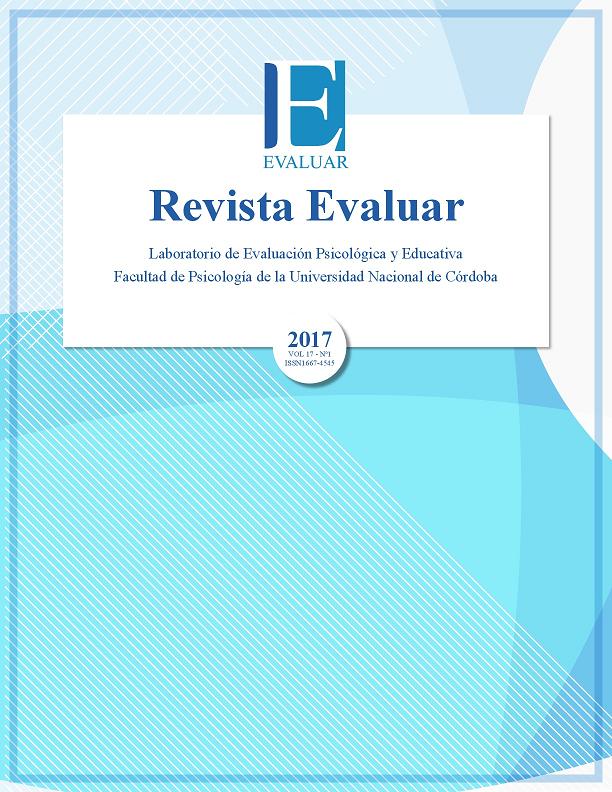Infant Scale of Selective Attention: A Proposal to Assess Cognitive Abilities
DOI:
https://doi.org/10.35670/1667-4545.v17.n1.17077Keywords:
Infant development, cognition, selective attention, assessment scaleAbstract
The aim of this research was to test the Infant Scale of Selective Attention (EEAS, in Spanish) on healthy infants with no suspected neurological damage, in order to obtain normalcy initial parameters for the use of the instrument.
The sample consisted of two hundred babies between two and eight months of age who were enrolled in the daycares of the Instituto Mexicano del Seguro Social. To obtain the normalcy initial parameters, descriptive statistics were used to calculate the mean, the standard deviation, the minimum and maximum scores, and percentiles. The EEAS allows for identification of delays in the development of the attention process by comparing an individual score to their age group in the tables. The findings of this study suggest that EEAS is a useful tool to evaluate the development of the attention process during infancy.
Downloads
References
Bayley, N. (2006). Bayley Scales of Infant and Toddler Development® (3rd ed.). San Antonio: Psychological Corporation. Retrieved from http://www.pear-sonclinical.com/
Bluma, M., Shearer, S., Forman, A., & Hilliard, J. (1995). Portage Guide to Early Education, Manual and Checklist. Revised Edition and Guia Portage de Educacion Preescolar. Manual y Lista de Objetivos. Edicion Revisada. Cooperative Educational Service Agency.
Carrasco, M. (2014). Spatial Covert Attention. Oxford Handbooks Online. doi: 10.1093/oxford-hb/9780199675111.013.004
Clarkson, M. G., & Berg, W. K. (1983). Cardiac orienting and vowel discrimination in newborns: Crucial stimulus parameters. Child Development, 54(1), 162-71. Retrieved from http://www.ncbi.nlm.nih.gov/pubmed/6831983
Colombo, J. (2001). The development of visual attention in infancy. Annual Review of Psychology, 52(1), 337-367. doi: 10.1146/annurev.psych.52.1.337102
Gomes, H., Molholm, S., Christodoulou, C., Ritter, W., & Cowan, N. (2000). The development of auditory attention in children. Frontiers in Bioscience: A Journal and Virtual Library, 5. Retrieved from http://www.ncbi.nlm.nih.gov/pubmed/10702373
Gomes, H., Wolfson, V., & Halperin, J. M. (2007). Is there a selective relationship between language functioning and auditory attention in children? Journal of Clinical and Experimental Neuropsychology, 29(6), 660-668. doi: 10.1080/13803390600920455
Gutiérrez-Hernández, C., & Harmony, T. (2007). Evaluación conductual de la atención selectiva visual y auditiva en lactantes con factores perinatales de riesgo de daño cerebral. Revista de Neuropsicología, 2(1), 3-9. Retrieved from http://www.imbiomed.com.mx/1/1/articulos.php?method=showDetail&id_articulo=49076&id_seccion=2642&id_ejemplar=4976&id_revista=159
IBM Corporation. (2009). IBM SPSS Statistics (17).
Instituto Mexicano del Seguro Social. (2015). Procedimiento para la inscripción y registro de asistencia de las niñas y niños en las guarderías de prestación indirecta. Retrieved from http://siag.imss.gob.mx/instalacionsiag/Guarderias/Normas/Portal/Pocedimiento.PI.PDF
Kushnerenko, E. V., Van den Bergh, B. R. H., & Winkler, I. (2013). Separating acoustic deviance from novelty during the first year of life: A review of event-related potential evidence. Frontiers in Psychology, 4, 595. doi: 10.3389/fpsyg.2013.00595
Markant, J., & Amso, D. (2013). Selective memories: Infants’ encoding is enhanced in selection via suppression. Developmental Science, 16, 926-940. doi: 10.1111/desc.12084
Markant, J., & Amso, D. (2014). Leveling the playing field: Attention mitigates the effects of intelligence on memory. Cognition, 131, 195-204. doi: 10.1016/j.cognition.2014.01.006
Markant, J., & Amso, D. (2016). The development of selective attention orienting is an agent of change in learning and memory efficacy. Infancy, 21(2), 154-176. doi: 10.1111/infa.12100
Matas, S., Maureen de Mulvey, M., Paone, S., Segura, E., & Tapia, L. (1997). Estimulación temprana de 0 a 36 meses (5th ed.). Buenos Aires: Lumen-Hvmanitas.
Morrongiello, B. A., Fenwick, K. D., Hillier, L., & Chance, G. (1994). Sound localization in newborn human infants. Developmental Psychobiology, 27(8), 519-538. doi: 10.1002/dev.420270805
Petersen, S., & Posner, M. (2012). The attention system of the human brain: 20 years after. Annual Review of Neuroscience, 35(1), 73-89. doi: 10.1146/annurev-neuro-062111-150525
Posner, M. I., & Petersen, S. E. (1990). The attention system of the human brain. Annual Review of Neuro-science, 13, 25-42. Retrieved from http://cns-web.bu.edu/Profiles/Mingolla.html/cnsftp/cn730-2007-pdf/posner_petersen90.pdf
Posner, M. I., Rothbart, M. K., Sheese, B. E., & Voelker, P. (2014). Developing attention: Behavioral and brain mechanisms. Advances in Neuroscience (Hindawi), 2014, 1-9. doi: 10.1155/2014/405094
Reynolds, G. D. (2015). Infant visual attention and object recognition. Behavioural Brain Research, 285, 34-43. doi: 10.1016/j.bbr.2015.01.015
Reynolds, G. D., & Romano, A. C. (2016). The development of attention systems and working memory in infancy. Frontiers in Systems Neuroscience, 10, 15. doi: 10.3389/fnsys.2016.00015
Richards, J. E., & Casey, B. J. (1991). Heart rate variability during attention phases in young infants. Psychophysiology, 28(1), 43-53. Retrieved from http://www.ncbi.nlm.nih.gov/pubmed/1886963
Richards, J. E., Reynolds, G. D., & Courage, M. L. (2010). The neural bases of infant attention. Current Directions in Psychological Science, 19(1), 41-46. doi: 10.1177/0963721409360003
Ross-Sheehy, S., Oakes, L. M., & Luck, S. J. (2011). Exogenous attention influences visual short-term memory in infants. Developmental Science, 14(3), 490-501. doi: 10.1111/j.1467-7687.2010.00992.x
Salapatek, P., Aslin, R. N., Simonson, J., & Pulos, E. (1980). Infant saccadic eye movements to visible and previously visible targets. Child Development, 51(4), 1090. doi.: 10.2307/1129548
Sánchez-Pérez, M., Benavides-González, H., & Mandujano-Valdés, M. (2007). Valoración neuroconductual del desarrollo del lactante (VANEDELA): Manual. UAM, Unidad Xochimilco, División de Ciencias Biológicas y de la Salud. Retrieved from http://www.dicyt.com/publicaciones/valoracion-neuroconductual-de-desarrollo-del-lac-tante-vanedela
Wu, R., Gopnik, A., Richardson, D. C., & Kirkham, N. Z. (2011). Infants learn about objects from statistics and people. Developmental Psychology, 47(5), 1220-1229. doi: 10.1037/a0024023
Downloads
Published
Issue
Section
License
Copyright (c) 2017 Claudia Calipso Gutiérrez-Hernández, Thalia Harmony, Gloria Nélida Avecilla- Ramírez, Ivette Barrón-Quiroz, Verónica Guillén-Gasca, Guadalupe Trejo- Bautista, María Monserrat Bautista-Olvera

This work is licensed under a Creative Commons Attribution 4.0 International License.
Revista Evaluar aplica la Licencia Internacional de Atribuciones Comunes Creativas (Creative Commons Attribution License, CCAL). Bajo esta licencia, los autores retienen la propiedad de copyright de los artículos pero permiten que, sin que medie permiso de autor o editor, cualquier persona descargue y distribuya los artículos publicados en Evaluar. La única condición es que siempre y en todos los casos se cite a los autores y a la fuente original de publicación (i.e. Evaluar). El envío de artículos a Evaluar y la lectura de los mismos es totalmente gratuito.



